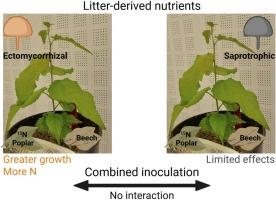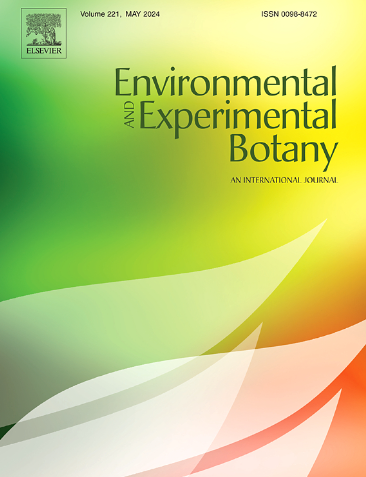Saprotrophic-ectomycorrhizal fungal interactions affect poplar performance
IF 4.7
2区 生物学
Q2 ENVIRONMENTAL SCIENCES
引用次数: 0
Abstract
Mycorrhizal and saprotrophic fungi are key players in plant nutrition in forest ecosystems, affecting nutrient availability and plant nutrient acquisition, but the impact of their interaction on plant performance remains largely understudied. Their interaction is particularly important under nutrient-limited conditions (e.g., nitrogen limitation) as they may compete for resources or engage in facilitative interactions that ultimately affect plant nutrient uptake and growth. Here, we used a simplified, plant-centric experimental design to investigate the effects of fungal interactions on plant performance. Poplar (Populus × canescens) plantlets were grown under nutrient-poor conditions for 23 weeks with a single nutrient source: a mixture of 15N-labelled poplar (labile) and beech (recalcitrant) leaf litter. Plants were inoculated with Pholiota squarrosa (saprotrophic), Laccaria bicolor (ectomycorrhizal), both, or neither. We analysed growth, nitrogen uptake, and photosynthetic performance.
Ectomycorrhizal-inoculated plants showed greater growth, root development, and nitrogen accumulation than non-inoculated controls or those inoculated with saprotrophic fungi alone. Photosynthetic performance, particularly at 16 weeks, was also enhanced. In contrast, saprotrophic fungi increased nitrogen concentration in roots but did not improve plant biomass. Plant biomass and root architecture did not differ between EMF-only and dual-inoculated plants, suggesting that the addition of saprotrophic fungi did not further enhance or impair these traits. However, for nitrogen-related traits, dual-inoculated plants showed intermediate values between EMF-only and STF-only treatments. Despite these trends, statistical analysis did not detect a significant interaction between fungal guilds. These findings indicate that ectomycorrhizal fungi play a stronger role in promoting plant performance under nitrogen-limited conditions, likely through enhanced nutrient uptake and photosynthetic efficiency. Saprotrophic fungi alone did not promote plant growth under the experimental conditions, nor did their presence alter the benefits conferred by ectomycorrhizal fungi.

腐生菌根-外生菌根真菌相互作用影响杨树生长性能
菌根真菌和腐养真菌是森林生态系统中植物营养的关键参与者,影响养分的有效性和植物养分的获取,但它们的相互作用对植物生长性能的影响仍未得到充分研究。它们的相互作用在营养有限的条件下(例如氮限制)尤为重要,因为它们可能竞争资源或参与促进相互作用,最终影响植物的营养吸收和生长。在这里,我们使用了一个简化的,以植物为中心的实验设计来研究真菌相互作用对植物性能的影响。在营养不良的条件下,杨树(Populus × canescens)幼苗在单一营养源下生长23周:15n标记的杨树(不稳定)和山毛榉(顽固性)凋落叶的混合物。植株分别接种腐养型白毛菌(Pholiota squarrosa)、外生菌根型双色毛毛菌(Laccaria bicolor)、两者都接种或不接种。我们分析了生长、氮吸收和光合性能。接种外生菌根的植株比未接种对照或单独接种腐养真菌的植株生长、根系发育和氮积累更快。光合性能也有所提高,特别是在第16周。腐养真菌提高了根系氮浓度,但没有提高植物生物量。单emf和双emf接种植株的生物量和根构型没有差异,表明添加腐养真菌不会进一步增强或损害这些性状。而在氮相关性状方面,双接种植株表现为介于emf和stf处理之间的中间值。尽管有这些趋势,统计分析并没有发现真菌行会之间有显著的相互作用。这些结果表明,在氮限制条件下,外生菌根真菌可能通过提高养分吸收和光合效率,在促进植物生产性能方面发挥更大的作用。在实验条件下,腐养真菌本身并不能促进植物生长,它们的存在也不会改变外生菌根真菌所带来的益处。
本文章由计算机程序翻译,如有差异,请以英文原文为准。
求助全文
约1分钟内获得全文
求助全文
来源期刊

Environmental and Experimental Botany
环境科学-环境科学
CiteScore
9.30
自引率
5.30%
发文量
342
审稿时长
26 days
期刊介绍:
Environmental and Experimental Botany (EEB) publishes research papers on the physical, chemical, biological, molecular mechanisms and processes involved in the responses of plants to their environment.
In addition to research papers, the journal includes review articles. Submission is in agreement with the Editors-in-Chief.
The Journal also publishes special issues which are built by invited guest editors and are related to the main themes of EEB.
The areas covered by the Journal include:
(1) Responses of plants to heavy metals and pollutants
(2) Plant/water interactions (salinity, drought, flooding)
(3) Responses of plants to radiations ranging from UV-B to infrared
(4) Plant/atmosphere relations (ozone, CO2 , temperature)
(5) Global change impacts on plant ecophysiology
(6) Biotic interactions involving environmental factors.
 求助内容:
求助内容: 应助结果提醒方式:
应助结果提醒方式:


